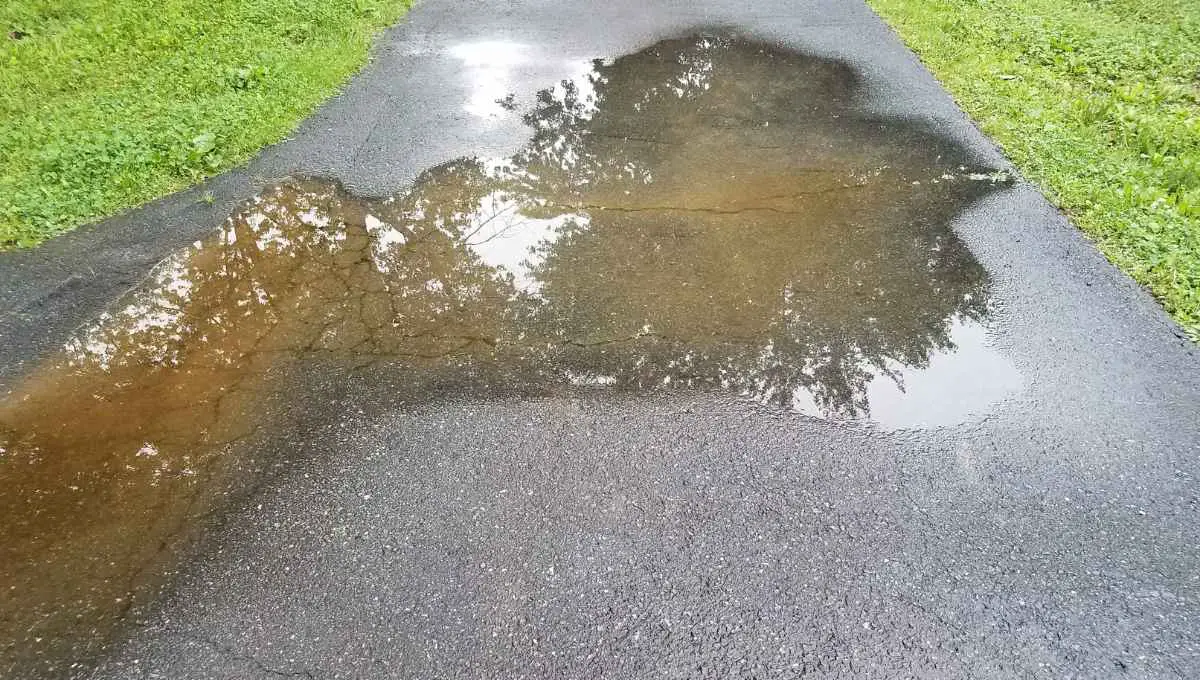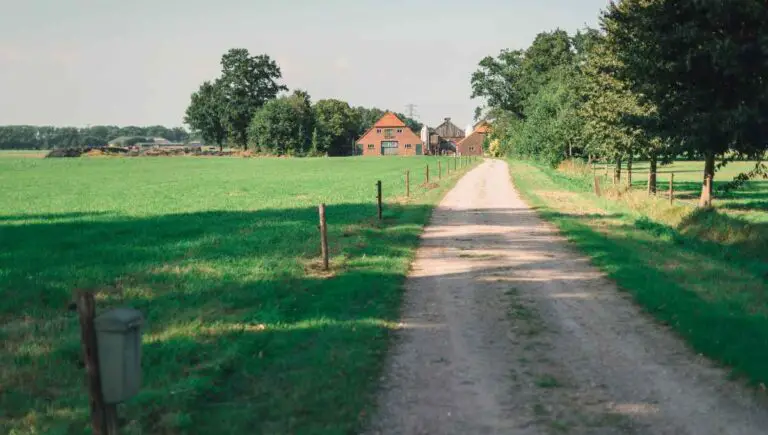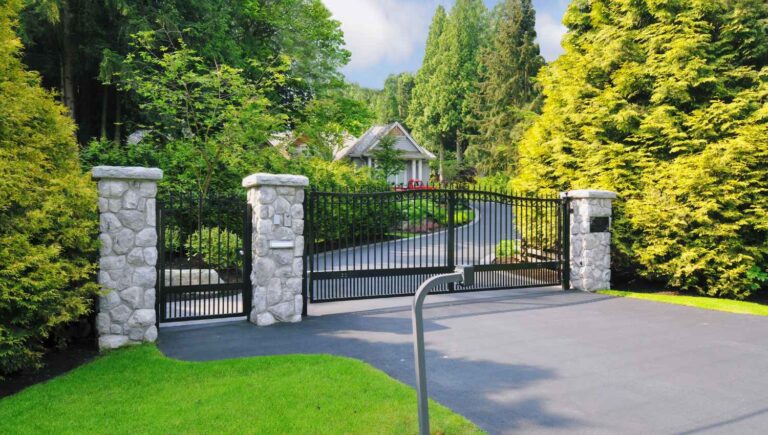How Do I Stop Rainwater Coming Down My Driveway? (Do This)

If you’re like me, you love the sound of rain. It brings peace and calm. However, if your driveway is suffering due to excessive rain draining into it, you may have a very different opinion on rainstorms. It may lead you to wonder, how do I stop rainwater coming down my driveway?
One solution for stopping rainwater from coming down your driveway is by adding gradients or installing drains. By sloping the driveway and directing the flow of water towards drains, you can effectively prevent rainwater from pooling and causing damage.
However, there are many reasons why your driveway is collecting rainwater and just as many ways to prevent or fix the issues. So stick with us while we talk through the options!
This post contains affiliate links from Amazon and other stores. This means Yard Blogger may earn a commission if you make a purchase using any of our links. Please refer to our full affiliate disclosure policy for full details.
Here’s a Quick Pro Tip!
Before it rains again, make sure you have the proper precautions in place. These are three great options to keep your driveway in top shape before, during, and after a rainstorm:
1. Drainage System – Install these drains along the side of your driveway to give water runoff a place to go.
2. Sealant – Sealing your driveway every three years helps prevent standing water.
3. Long Squeegee – After the storm, remove any standing water to prevent ice and cracks.
What Puddles in the Driveway Mean
If you’re getting puddles in your driveway, it could mean your driveway isn’t sloped enough. Unfortunately, that may mean your driveway is more prone to cracks and potholes due to water damage.
You don’t want rainwater to puddle in your driveway. If it’s getting cold out, the water can get into small cracks and freeze, potentially causing larger cracks and even more issues. If you aren’t ready to repave your driveway, you want to prevent that from occurring!
The best way to stop water from puddling in your driveway is to divert it elsewhere. There are a couple of ways to do this. The first is to use a diverter to prevent water from reaching your driveway in the first place.
However, a diverter won’t stop the rainwater that naturally falls onto your driveway; it just prevents runoff from other places from getting onto the drive. To prevent rain puddles, your driveway needs to be graded properly, and then you can install drains to divert the water.
Redirecting the Water
If you don’t want to add actual drains to your driveway or aren’t ready for a construction project of that magnitude, there is another option. You can dig a small trench on either side of your driveway for runoff.
You’ll want to fill it most of the way with gravel and direct it either to an existing drain or water source so that the water does not end up puddling elsewhere instead.
If you’re noticing that most of your water is coming from your home’s gutters, consider adding a downspout diverter to prevent water from hitting your driveway in the first place.
Is Your Driveway the Problem?
There should never be standing water puddling on your driveway, even after a rainstorm. If you’re noticing puddles, odds are your driveway isn’t sloped correctly, or your drainage system isn’t working properly.
Driveways that do not drain properly risk developing cracks and potholes. If the weather is cold, that puddle can also turn into black ice, which can be very dangerous.
Additionally, that water may penetrate the asphalt or concrete of your driveway, causing irreparable damage.
Warning Signs to Check for After a Storm
If you see standing water on your driveway after a rainstorm and you already have a drainage system in place, you will need to check it for blockages. It may be that debris from a storm has caused it to back up and be ineffectual.
If so, you’ll need to clean out the debris. You can do that manually (make sure to wear gloves!) or get yourself a pressure washer with a telescoping pressure washer wand, which can extend up to 18 feet to help you easily clear away blockages!
Now, just to clarify, depending on the strength of the storm, it may take a little time for puddles to drain off your driveway.
So you shouldn’t panic and assume your drains are blocked if you’ve gotten a large amount of rain in a short period and it’s still standing on the driveway.
However, if it’s been hours and the puddles aren’t dissipating at all, then it may be time to be concerned. Those kinds of puddles often signify a deeper problem but don’t worry; we’re about to talk about how to get rid of those pesky puddles!
Porous Problems
Most driveway materials are naturally porous. Looking at you, concrete and asphalt! Typically, that porousness will allow rainwater to filter naturally through your driveway and into the ground.
However, if the ground is already saturated, that could be a problem. This is one reason it’s recommended that you have a layer of gravel underneath concrete and asphalt driveways, as it helps the water drain.
One way to attempt to solve this issue is to seal your driveway. If water is left to puddle on your driveway, not only will cracks form, but you may even find your driveway turning black!
Draining the Puddles
The best driveway drainage solution is to ensure your driveway is sloped properly so it can drain off rainwater and to add drains to ensure there will no longer be standing water. If that is not enough, you may need to add a swale to your property.
A swale is defined as a shallow channel with gently sloping sides, typically designed to manage water runoff and increase rainwater infiltration. You can even use them to collect rainwater if you are so inclined!
You can also dig a shallow trench next to your driveway to encourage rainwater to drain off and into the trench. We recommend filling the trench at least halfway full of gravel or small rocks to help with drainage.
You May Need to Go Old-School
While drains and swales are great long-term solutions, it doesn’t help at the moment. If the puddle is already there, what do you do? The answer is simple, move the water away!
You can use a long broom or, most preferably, a long squeegee to move the water off your driveway and into your yard.
Once you’ve got the water off your driveway, you may want to contact a professional for their opinion on how to best fix your driveway drainage problems. After all, you want your driveway done right so that this doesn’t happen again.
They will recommend the drainage system or maintenance routines you need in order to stop rainwater from coming down your driveway in the first place, so you never have to worry about puddles again!
You might also enjoy our post on How Soon Can You Walk on a New Driveway?
Final Thoughts
No one wants to deal with rainwater coming down their driveway. Unfortunately, it can erode the driveway and cause cracks and puddles, leading to even bigger issues.
If you’re having these problems, we recommend installing drains and water diverters to prevent the water from hitting your driveway in the first place.
While these solutions may seem a bit expensive up front, they will save you money in the long run because replacing your whole driveway due to water damage is certainly more expensive!











